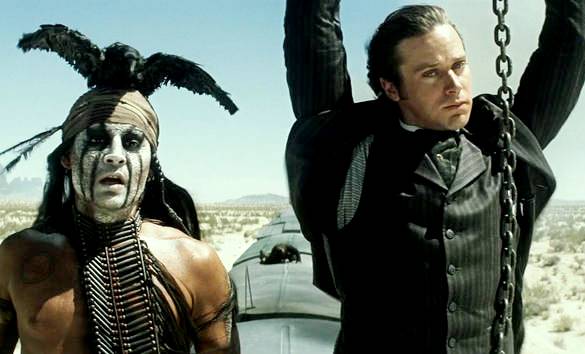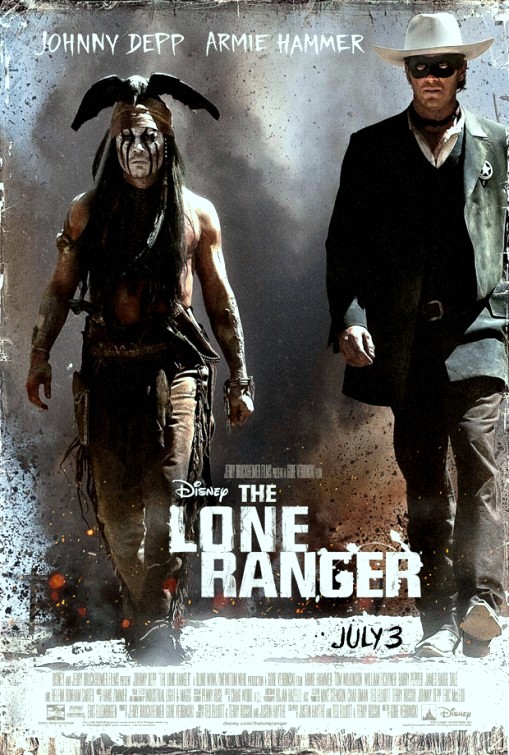
I wish the entire movie had been as good as the final 20 minutes. The Lone Ranger has amazing surface beauty, which must be credited to director Gore Verbinski (“Pirates of the Caribbean,” “Rango”). The movie was filmed in six different states, but mad props to Mother Nature that created the Monument Valley of Utah and the Cimarron Canyon State Park of New Mexico. Armie Hammer is self-knowingly square as lawman John Reid and Johnny Depp is the oddball Native American Tonto (Depp? Oddball? You guessed it). I do wish our hero wasn’t so square though, for he can’t get the job done – there must be three climaxes, and only the last one is awesome.
The complicated framework is kind of charming: In 1933 San Francisco, a little boy in dress-up cowboy outfit meets Tonto at an exhibit, who tells a mighty long legend. Tonto begins by how he and Reid a.k.a. The Lone Ranger, once robbed a bank. But hold on, the hero robbed a bank? The movie intrigues us, and gets us wondering, how the do-goody lawman could have ever gotten himself into a bit of larceny. There’s also the matter of taking down bad guy Butch Cavendish (William Fichtner), who shares a hideous resemblance to Wild Bill but is wholly unredeeming. Tom Wilkinson and Barry Pepper also appear as corrupt officials.
Before our eyes are natural wonders galore, with shots as transporting as the best of the 1960’s westerns by Sergio Leone. But Verbinski, so gifted at staging epic scale shots, probably needed to cut at least ten scenes to keep this moving along at a more pleasant clip. Sometimes his actors spend too much time, um, acting. Helena Bonham Carter, as a saloon owner with a gun for a leg (What is this? “Wild Wild West?” “Jonah Hex?”), drawls out her dialogue in a way that drives her scenes to go on and on. I wanted her to stop talking. But it was at about this point where “The Lone Ranger” stopped modeling itself as an old-fashioned classic like “Once Upon a Time in the Western” or “Little Big Man” and became post-modern western trash like, err, “Jonah Hex.”
 I wasn’t enthralled like I should have been, and the reason could be the company we’re with. The Reid and Tonto camaraderie is a little too unusual, kind of anti-friends. Because they are not great friends (not that we can see), the two of them naturally don’t fight well against the outlaws of the Old West. They just sort of get stuck, one of them or the other, in odd predicaments that lead to one dragging the other one out of trouble.
I wasn’t enthralled like I should have been, and the reason could be the company we’re with. The Reid and Tonto camaraderie is a little too unusual, kind of anti-friends. Because they are not great friends (not that we can see), the two of them naturally don’t fight well against the outlaws of the Old West. They just sort of get stuck, one of them or the other, in odd predicaments that lead to one dragging the other one out of trouble.
But so much walloping thrills in that runaway train climax are to be had, which is like Buster Keaton’s “The General” mixed with Jackie Chan’s “Shanghai Noon” further mixed with Steven Seagal’s “Under Siege 2: Dark Territory” with lots of overcranked speed, train cars running parallel tracks side to side with good and evil on opposite sides, train cars jumping tracks, coal cargo flipping over, and dodges of both bullets and tree branches and natural forces. The William Tell Overture, employed just like the 1933 radio program and 1949 TV series, is terrifically updated during this. It makes the entire sequence gallant, exciting and rhapsodic. The rest of the movie needed equal cheer. Oh, and I wanted to know who the parents were to that 1933 San Francisco boy.
140 Minutes. Rated PG-13.
ACTION & ADVENTURE / WESTERN / WEEKEND MATINEE
Film Cousins: “Once Upon a Time in the West” (1969); “Little Big Man” (1970); “The Outlaw Josey Wales” (1976); “Jonah Hex” (2010).





